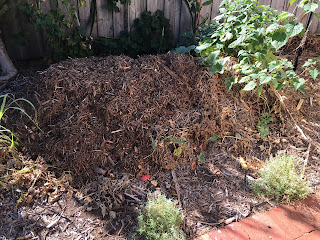Making a Hugelkultur
Last year I stumbled across a website demonstrating a "no water" garden, called a "hugelkultur, which is a raised garden bed filled with rotten wood. Intrigued, I eyed off the woolly bushes we had
 |
| Goodbye woolly bushes |
at the side of the house, which were very old, rambling, and performing no useful function other than blocking us from the neighbour's house. In my eyes, this was a waste of productive land, since we had decided to make our 809 sq m block provide us with a sustainable food source some time ago.
The "no water" part intrigued me, since we live in Perth, a notoriously dry city with a hideously expensive municipal water supply. I liked the idea of "no water". The idea is you dig a trough, fill it with a mound of logs, cover it with compost and mulch, and seed the heck out of it. As the logs break down, they generate heat, absorb water, and give out a constant supply of nutrients for 20 years or so. It takes a couple of years for the mound to break down enough to absorb water, so you need to water it through the hot months until that stage.
The problem of termites occurred to me, but, as I looked around, the little buggers were everywhere anyway, breaking down wood in both wanted and unwanted locations. By giving them something to work on, I was, in my mind, keeping them from bothering with my roof rafters. Plus you can buy termite traps and bury them near the lure, and help further keep them under control.
 |
All the woody bits got piled up. We left one woolly bush
at the fence to block the neighbour's view |
So I let my husband have the chainsaw (always a risky decision) and pointed him to the woolly bushes. The trunks then formed the hugelkultur mound, and we chipped the rest and made compost with it.
The chooks (chickens?) had obligingly produced a mound of poop-covered bark chips and straw over the past few months. This, and the compost from our three compost bins, covered the mound, after I first laid out some weeper hose to water the mound for the first couple of years or so.
Then I went through our seed box, and emptied everything I could find onto the mound. Some seeds were old, so they didn't really germinate all that well.
 |
| My Hugulkulture is taking shape! |
I decided to take the wire off at some point and I regret doing it as the mulch slided down, exposing the hugelkulture. If I ever did it again, I would use a coarse wire and leave it there to break down, releasing zinc and iron into the mound.
To water it I installed five lines of dripper hose over the wood and under the compost cover, the underground type that will conserve water. Over time, as this breaks down, I will no longer need to water so much, but because we have such harsh summers, I think I'll leave it in.
So this is what it looked like going into the first summer. Not very impressive, but I have hope. It did give me a heap of very healthy looking kale and spinach over the winter.
Following a very hot long summer the hugelkulture had condensed down to the extent that the base wood was starting to show through.
Everytime we lay a barkchip mulch around (free courtesy of the local council), it drags nitrogen from the base as it breaks down. So this year, we emptied our compost bin over the hugelkulture, then covered it with 10cm or so free horse manure from the horse property around the corner. He was glad to get rid of the manure and we were glad to have a free, spreadable nitrogen source.
Then we covered the mound with bark chips to mulch it and flung a few handfuls of seeds over it. Then we planted strawberries, blueberries and goji berries into the top.
I"ll post updates as we go.
Update: The photo below is our hugulkulture in its second year. Horse manure and bark chips have revived it, and we will get a massive crop of berries and garlic from it.

 The final stage was to put the other tyre on top, and fill it up with compost and nice
organic soil, and put my plant into it. I filled the well with water by
putting the hose into the PVC pipe. Any surplus water should spill out
the top of the bottom tyre. I wedged it open a bit with a thick stick to
let that happen.
The final stage was to put the other tyre on top, and fill it up with compost and nice
organic soil, and put my plant into it. I filled the well with water by
putting the hose into the PVC pipe. Any surplus water should spill out
the top of the bottom tyre. I wedged it open a bit with a thick stick to
let that happen.






















